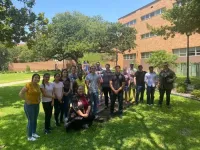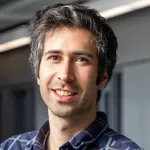(Press-News.org) MADISON, Wis., - Carbon dioxide removal (CDR) technologies that could be critical tools to combat climate change have developed in line with other technologies from the last century. However, according to new studies led by Gregory Nemet, a professor at the University of Wisconsin–Madison, these technologies need to develop faster to meet policy targets aimed at limiting global warming.
As policymakers, researchers and climate activists from around the world prepare to meet for the UN Climate Change Conference beginning on November 30, 2023, one lingering question is whether climate technologies are developing and scaling quickly enough to meet the demands of the Paris Agreement.
New research led by Nemet, who is a professor in the La Follette School of Public Affairs, finds that novel CDR methods need to scale at a much faster rate to meet the Paris Agreement’s temperature goal of limiting warming to 2 or 1.5 degrees Celsius. That goal would require removing hundreds of gigatons of carbon dioxide from the atmosphere over the course of the century, making the scaling of novel CDR technologies particularly important.
CDR involves capturing CO2 from the atmosphere and storing it in a variety of ways. Examples of conventional CDR include reforestation, wetland restoration and improved forest management. All other CDR methods have only been deployed at small scale and are collectively known as novel CDR. Examples include bioenergy with carbon capture and sequestration, direct air carbon capture and storage, and biochar. These new methods may be able to offer more durable carbon storage than conventional methods that rely on trees and soils.
In one of their recent papers published October 30, 2023, in Communications, Earth & Environment, Nemet and his research team debut the Historical Adoption of TeCHnology (HATCH) dataset — an innovative project that tracks and analyzes a variety of agricultural, industrial and consumer technologies adopted over the past century that can provide insight into the scale-up of new technologies such as carbon removal.
The study analyzed the emergence and growth of 148 technologies across 11 categories going back to the early 20th century. It then cross-referenced this data with model CDR scenarios established by the Intergovernmental Panel on Climate Change (IPCC), company announcements of CDR scale-up plans, and CDR targets in policy announcements.
While the paper found evidence that the required scale-up of carbon removal technologies fits within the historical range of previous efforts, company announcements and government targets implied there would be much faster growth than the historical record and IPCC CDR modeled scenarios.
“The scale-up rates needed for carbon removal to meet the 2- and 1.5-degree Celsius targets are within the range of historical experience, even if at the high end,” says Nemet. “We can learn from that experience to facilitate getting carbon removal to climate-relevant scale over the next three decades.”
In another paper published November 15, 2023, in Joule, Nemet and his research team find that 2 gigatons of carbon dioxide removal per year is currently taking place. Nearly all of that removal is accomplished by planting more trees and only 0.1% from novel CDR.
This is all despite modeling scenarios that show that we need to remove hundreds of gigatons of carbon dioxide from the atmosphere over the course of the century to meet the Paris Agreement and ensure the sustained wellbeing of our planet.
The study finds that virtually all scenarios that limit warming to 1.5 or 2 degrees Celsius require novel CDR. On average, scenarios increase novel CDR by a factor of 1,300 by mid-century.
By looking at the period of time between when a technology is introduced to the market and when rapid scale-up of its production occurs — called the formative phase — the paper suggests that this part of the process for direct air carbon capture and storage and other novel CDR methods must accelerate to meet the needs of a warming planet. Speeding up the innovation that occurs during this phase to begin a higher volume of production sooner could help improve technology adoption.
“To become climate relevant, the formative phases for air filter systems and other novel methods of carbon removal need to be at least as active as the fastest historical analogues,” says Jan Minx, head of the Mercator Research Institute on Global Commons and Climate Change working group Applied Sustainability Science and a co-author of both studies. “This will require more serious commitments toward novel removal technologies than are currently in place. The required levels will only be feasible if we see substantial development of novel CDR’s formative phase in the next 15 years.”
The results of these studies will also be included in the forthcoming 2023 UN Emissions Gap Report, which includes a chapter on carbon removal with contributions by Minx and Nemet.
###
END
Associate Professor of physics Benjamin Jones has received a $341,571 grant from the U.S. Department of Energy to continue his successful traineeship program at The University of Texas at Arlington.
The program exposes undergraduate students to opportunities in particle and nuclear physics, which offer key components in many diverse careers, such as nuclear medicine, radiation therapy, archaeology, precision management and astrophysics.
UTA’s Nuclear Research Experiences for Minority Students (NREMST) started in 2021 with the goal of immersing students from historically underrepresented populations in nuclear physics.
“We know that many students ...
A major new research project will explore the impact of transformational changes to mental health treatment in South America.
Community-based care for people with psychosocial disabilities began in the region in the 1960s and 1970s, when a minority of people were moved from large and isolated psychiatric hospitals to residential alternatives in the community.
This policy was promoted by the World Health Organization and the Pan America Health Organization and is considered a defining element of the modernisation of mental health systems. But in current analysis of this process the ethical, social and political tensions associated ...
Scientists have discovered that bacteria can create something like memories about when to form strategies that can cause dangerous infections in people, such as resistance to antibiotics and bacterial swarms when millions of bacteria come together on a single surface. The discovery — which has potential applications for preventing and combatting bacterial infections and addressing antibiotic-resistant bacteria — relates to a common chemical element bacterial cells can use to form and pass along these memories to their progeny over later generations.
Researchers ...
CORVALLIS, Ore. – Forest modeling by Oregon State University scientists shows that a site’s productivity – an indicator of how fast trees grow and how much biomass they accumulate – is the main factor that determines which time period between timber harvests allows for maximum above-ground carbon sequestration.
The findings, published in the journal Forests, are important for Pacific Northwest forest managers seeking to strike an optimal balance between harvesting and carbon sequestration, an important tool in the fight against climate change.
The study by Catherine Carlisle, Temesgen Hailemariam ...
People who speak two languages may be better at shifting their attention from one thing to another compared to those who speak one, according to a study published this month in the journal Bilingualism: Language and Cognition.
The study examined differences between bilingual and monolingual individuals when it comes to attentional control and ignoring information that isn’t important at the time, said its authors Grace deMeurisse, a University of Florida Ph.D. candidate studying linguistics, and Edith Kaan, ...
(MEMPHIS, Tenn. – November 21, 2023) Findings from St. Jude Children’s Research Hospital are moving the field of cancer immunotherapy one step closer to treating brain and solid tumors. Scientists at St. Jude validated a cellular immunotherapy target called 78-kDa glucose-regulated protein (GRP78) in proof-of-principle experiments. The group also discovered a resistance mechanism whereby some tumors trick the cancer-killing immune cells into expressing GRP78, thereby turning off the immune cells or causing them to be killed, too. The research, which has implications for developing immunotherapy for the broad range of difficult-to-treat ...
TORONTO, Nov. 21, 2023 – Faced with images that break the expected pattern, like a do not enter sign where a stop sign is expected, how does the brain react and learn compared to being shown images which match what was predicted?
That was the question a team, including York University, set out to answer. A long-standing theory suggests the brain learns a predictive model of the world and its internal predictions are updated when incoming sensory data proves them wrong. However, what the researchers found surprised them, says York Faculty of Science Associate Professor Joel Zylberberg, co-corresponding author of the newly published paper.
“Testing ...
A new analysis sheds light on the molecular processes involved when a carnivorous species of fungus known as Arthrobotrys oligospora senses, traps and consumes a worm. Hung-Che Lin of Academia Sinica in Taipei, Taiwan, and colleagues present these findings November 21st in the open access journal PLOS Biology.
A. oligospora usually derives its nutrients from decaying organic matter, but starvation and the presence of nearby worms can prompt it to form traps to capture and consume worms. A. oligospora is just one of many species of fungi that can trap and eat very small animals. Prior research has illuminated some of the biology behind this ...
In Germany, taxing sugar-sweetened beverages could prevent or postpone cases of type 2 diabetes, extend healthy lifespans and save up to €16.0 billion in societal costs over the next 20 years, according to a new study led by Karl Emmert-Fees of the Technical University of Munich, published November 21st in the open access journal PLOS Medicine.
The World Health Organization has recommended that governments worldwide lessen the social and economic burden of cardiometabolic disease by taxing sugar-sweetened beverages. These taxes either reduce consumption by increasing the price, such as the one peso per liter ...
A simulation study conducted by a team from the Technical University of Munich (TUM) demonstrates that a soft drink tax in Germany would have significant positive effects. In all of the simulated variants evaluated, less sugar was consumed and the rate of illness dropped. This would be a way to reduce costs to the national economy and alleviate the burden on the health care system. There is, however, a difference between taxes aimed at reducing soft drink consumption and taxes aimed at bringing about changes in product formulation.
Sugary beverages increase the risk of obesity and illnesses such as diabetes. Several countries have therefore introduced taxes on soft drinks. In Germany ...






